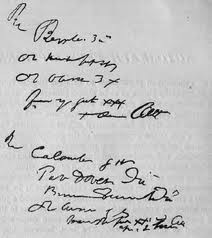 Griffonage means carelessly written handwriting; it means crude or illegible scrawl. There are millions of people who seem to not bother whether their notes, writings can be read by others or not. These include students, doctors, lawyers, architects and many more. Poor handwriting has pitiable rhythm and many inconsistencies. They appear as crow’s legs, weeds, slanting sticks – in short poor or illegible handwriting gives rise to headache to the reader. Examiners usually tend to become unsympathetic towards scribbled answer sheets. People with poor handwriting always find themselves having to make an apology.
Griffonage means carelessly written handwriting; it means crude or illegible scrawl. There are millions of people who seem to not bother whether their notes, writings can be read by others or not. These include students, doctors, lawyers, architects and many more. Poor handwriting has pitiable rhythm and many inconsistencies. They appear as crow’s legs, weeds, slanting sticks – in short poor or illegible handwriting gives rise to headache to the reader. Examiners usually tend to become unsympathetic towards scribbled answer sheets. People with poor handwriting always find themselves having to make an apology.
The biggest universal problem we all face is reading doctor’s prescriptions. The best part is the chemist can only read the prescriptions of doctors. The most important reason given for this reality is doctors have to write a lot and fast. Their business is largely volume-driven and they say that it is taxing for them to write so many notes in the case papers and prescriptions. The second reason perhaps could be that in medical practice nobody forces them to write legibly. Some doctors see 100-200 patients a day, they run from one clinic to another, at times seeing patients for more than twelve hours. I think writing badly for doctor is a matter of survival.
The problem for doctors is the volume of paperwork that needs to be done for each patient in ward and outdoor. For legal reasons, everything done, found, or instructed, has to be documented prior to discharge. Doctors and their assistants are therefore busy to finish the paperwork.
 Graphology which means handwriting analysis suggests that ugly handwriting indicates a certain amount of emotional baggage. Many horrible writers tend to be psychologically volatile; at times even bad tempered. Ugly handwriting can also indicate a lack of stability and a number of other things too. But then this analysis does not go well with professionals like doctors, lawyers and other high-end professionals.
Graphology which means handwriting analysis suggests that ugly handwriting indicates a certain amount of emotional baggage. Many horrible writers tend to be psychologically volatile; at times even bad tempered. Ugly handwriting can also indicate a lack of stability and a number of other things too. But then this analysis does not go well with professionals like doctors, lawyers and other high-end professionals.
At times, poor handwriting can be an indication of a low self esteem. If the writer decides he/she can start writing in legible hand. Buy a good ballpoint, roller-balls, or even felt tips and start making an effort; so look for a pen that’s comfortable to hold, and where the ink flows smoothly without your having to push too hard on the paper. Sit in a comfortable posture. You need to sit up straight yet relaxed, with your non-writing fingers gently curled under your hand, and your hand position resting lightly on the table.
Take every opportunity to write in good handwriting. Start maintaining a diary, write everyday notes in it. Make an effort of writing legible handwriting on cheques, bills; just you need to make up your mind. Practice your handwriting for a few minutes each day, and you should start to see improvements quite quickly. Try making up motivational sentences that use letters in different ways.
Writing is not an easy skill; it requires the ability to organize and express ideas in the mind. It also requires the ability to get the muscles in the hands and fingers to form those ideas, letter by letter, on paper. Please think of so many people who must be having tough time reading your handwritten notes, letter, and postal addresses. When a sorting machine discovers an illegible address in post office, what do the postal employees do? What can the postman do? He tries his level best to deliver it at the right address but if the handwriting is terrible, it goes to a wrong address.
Before I finish, handwriting is very personal. It is an expression of a person’s identity, like how the person dresses or styles his hair. Handwriting changes from childhood to adulthood at various stages in life. Adopt a particular style of handwriting to suit your personal image. Invest time and energy in your handwriting – it’s worth it!













































